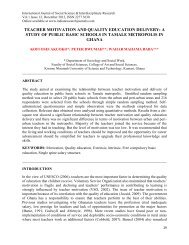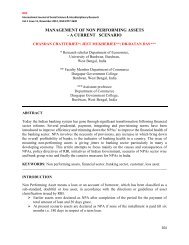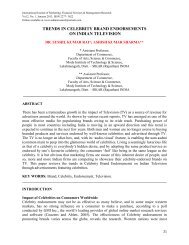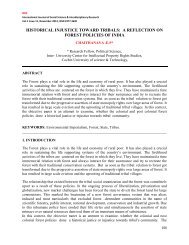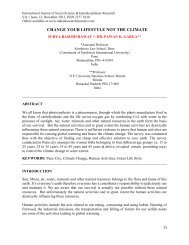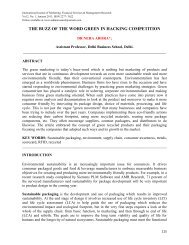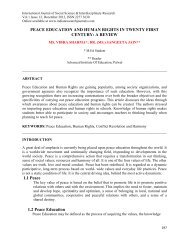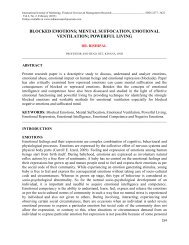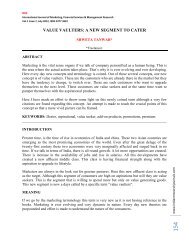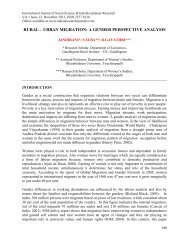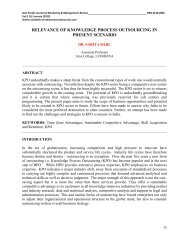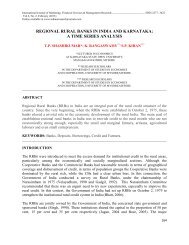application of remote sensing and gis for flood risk analysis: a case ...
application of remote sensing and gis for flood risk analysis: a case ...
application of remote sensing and gis for flood risk analysis: a case ...
You also want an ePaper? Increase the reach of your titles
YUMPU automatically turns print PDFs into web optimized ePapers that Google loves.
IRJC<br />
International Journal <strong>of</strong> Social Science & Interdisciplinary Research<br />
Vol.1 Issue 11, November 2012, ISSN 2277 3630<br />
2. A post-processor, which imports the model output <strong>and</strong> displays it as a GIS layer.<br />
The interface method basically automates the data interchange method. The automation is<br />
accomplished by adding model-specific menus or buttons to the GIS s<strong>of</strong>tware interface. The<br />
model is executed independently from the GIS; however, the input file is created, at least<br />
partially, from within the GIS. The main difference between the interchange <strong>and</strong> interface<br />
methods is the automatic creation <strong>of</strong> a model input file.<br />
U.S. Army Corps <strong>of</strong> Engineers HEC-GeoRAS s<strong>of</strong>tware is a good example <strong>of</strong> the interface<br />
method. Developed as an ArcView GIS extension, GeoRAS allows users to expediently create<br />
input data <strong>for</strong> their HEC-RAS models. Additional GeoRAS in<strong>for</strong>mation is provided below.<br />
Integration Method<br />
GIS integration is a combination <strong>of</strong> a model <strong>and</strong> a GIS such that the combined program <strong>of</strong>fers<br />
both the GIS <strong>and</strong> the modeling functions. This method represents the closest relationship<br />
between GIS <strong>and</strong> <strong>flood</strong>plain models. Two integration approaches are possible:<br />
1. GIS Based Integration: In this approach, modeling modules are developed in or are called<br />
from a GIS. All the four tasks <strong>of</strong> creating model input, editing data, running the model,<br />
<strong>and</strong> displaying output results are available in GIS. There is no need to exit the GIS to edit<br />
the data file or run the model. EPA's BASINS s<strong>of</strong>tware is a good example <strong>of</strong> this method.<br />
2. Model Based Integration: In this method GIS modules are developed in or are called from<br />
a computer model. Computation Hydraulics Int.'s (http://www.chi.on.ca/) PCSWMM GIS<br />
s<strong>of</strong>tware is a good example <strong>of</strong> this method.<br />
Because development <strong>and</strong> customization tools within most GIS packages provide relatively<br />
simple programming capability, the first approach provides limited modeling power. Because it<br />
is difficult to program all the GIS functions in a <strong>flood</strong>plain model, the second approach provides<br />
limited GIS capability. Applications are being developed to connect HEC-HMS <strong>and</strong> HEC-RAS<br />
models in a single ArcView GIS environment that would allow users to move easily from a<br />
DEM to a <strong>flood</strong>plain map within a single program (Kopp, 1998).<br />
Conclusion:<br />
Remote <strong>sensing</strong> data accumulated from past ten years <strong>and</strong> GIS data base <strong>of</strong> comm<strong>and</strong> area will<br />
give accurate progressive <strong>and</strong> environmental aspects <strong>for</strong> the best use <strong>for</strong> framing policy<br />
decisions. The study area <strong>of</strong> Raichur district has both Krishna <strong>and</strong> Tungabhadra river valley with<br />
both posing different set <strong>of</strong> in<strong>for</strong>mation‟s <strong>for</strong> specific policy framework in terms <strong>of</strong> settlement<br />
pattern <strong>and</strong> maintenance <strong>of</strong> post <strong>flood</strong> social economical <strong>and</strong> infrastructure fabric.<br />
One <strong>of</strong> the main aim <strong>of</strong> study is to take accurate decisions on future settlement pattern in order to<br />
avoid disaster effect in present river valley. Many ef<strong>for</strong>ts <strong>for</strong> disaster management by providing<br />
housing solution in upl<strong>and</strong> locations have failed to bring a change in the social fabric because <strong>of</strong><br />
locational disadvantage.<br />
60



